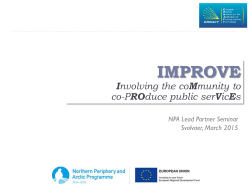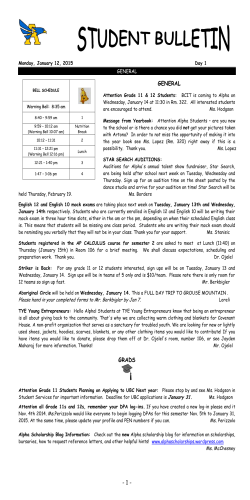
Living Laboratory and eHealth: People, Regulation, Industrial Partners
Living Laboratory and eHealth: People,
Regulation, Industrial Partners
András Kuba1, Tibor Török1, Csenge Csoma2, Peter Uhlir2, Emese Szabó2, Éva Ács3,
Annamária Takáts3
1
University of Szeged, Honvéd tér 6., 6722 Szeged, Hungary, {andkuba, tibor.torok}@inf.u-szeged.hu
2
GE Healthcare, Akron út 2., 2040 Budaörs, Hungary, {csengecsoma, peter.uhlir, emese.szabo}@ge.com
3
Mednet 2000 Kft., Testvérhegyi út 57, 1037 Budapest, [email protected], [email protected]
Abstract
When running eHealth research in Living Labs, a number of regulatory, ethical and methodological limitations
apply. This paper is a case study about an eHealth project running in Homokháti Living Lab (HLab). The goal of the
Alpha project is to create a telemonitoring system, to monitor subjects with no or with stable neurological disease.
The project runs in three living laboratories where tests are performed in a coordinated way.
Managing the information flow between the living lab users and other stakeholders proved to be an important task
that is far from straightforward when medical aspects play a role. The medical or the industrial stakeholders may
often need contextual information that cannot be provided by sensors but by human supervisors. This paper addresses
what kind of legal and medical regulations and protocols influence the work of the LL, how these problems surfaced
in our project and what kind of solutions we use to tackle them. The experiences are evaluated according to their
usefulness in the next phases of the LL.
Keywords
E-Health, living lab, home care, experimentation
1
Introduction
Telehomecare is one of the hot topics within eHealth for several years by now. [Demiris, 2004]
The concept enables a home based disease management and monitoring and thus fulfils the often
emerging desire of the patients to remain independent at home.
Living Labs provide good environment for testing and developing eHealth solutions, especially
telehomecare solutions. There are Living Labs in Europe that are specialized for eHealth
projects1.
Alpha is an eHealth project aiming the development of a telehomecare solution. Homokháti
Living Lab (HLab) works in the rural areas in southern Hungary and has been involved in
agriculture collaborative working projects [C@R]. HLab has been selected for testing the
solution in the rural areas. For defining the LL related operations within the Alpha project, our
approach was similar to the Action Research approach described in [Shaffers, et al. 2008].
Healthcare-oriented research is limited by several factors in general. The fact that humans are
involved in the tests and the sensitivity of personal data (and especially health status information)
many ethical and legal barriers have to be taken care of. Conversely, effective testing and
innovation in Living Labs would require flexibility. This paper is a case study that enumerates
the most distinctive limitations that emerged during the Alpha project and the solutions we used
to tackle those.
1
One example is Living Lab Salud Andalucía, which runs a project named Health and Remote Care (SARA) since
2009. (http://livinglabsalud.es/proyectos/ver/1/)
2
The Alpha Project
The mission of the Alpha project (www.proseniis.com) is to offer telemonitoring tools and
effective home care solutions for elderly or sick people and their families. The project is funded
by the National Office for Research and Technology in Hungary and concentrates on the
development of a ready-to-use remote home care solution including the hardware, the software
and the medical protocols. The solution is tested and refined in three Living Labs in Hungary.
The output of the project will be 1. a home care system prototype that monitors the patients’
health status and activities, 2. a service model for health care and home care service providers
that describes how to operate the system and shows a way to include it into their business.
2.1
Target domain
The project focuses on patients with no or with stable neurological disease. Brain diseases are a
major public health problem in Europe, on our „aging” continent. Considering the analysis of
the European Brain Council (EBC) across 28 European countries (EU plus Iceland, Norway and
Switzerland) with 466 million inhabitants, every fourth people are suffering at least from one
brain disease [EBC, 2008] .The total cost of brain diseases is about € 386billion. Among the 12
most costly diseases are Parkinson's disease, dementia (Alzheimer's disease) and stroke. [Olesen,
et al. 2006] In accordance with aging and much longer life expectancy the frequency of those
diseases is continuously growing. By estimation in 2040 the number of patients is going to be
doubled. [WHO, 2006] The present health insurance systems are less confident to the
expectation of the growing population of retired people. Establishment of a more economical
health care system supplied with the modern computerization is getting necessary. The Alpha
project focuses on the three diseases mentioned above for introduction of telemedicine:
Dementia, Parkinson’s disease and Stroke.
2.2
Benefits of a telemedical system
New opportunities are opened in health care by the telemedical system. The wireless sensors and
detectors planted in flats and wearing on the body give the possibility to observe the patient
activities and realise the changes in their status without overtasking the attendants in hospitals or
in surgeries.
The professional medical staff is continuously monitoring, processing and evaluating the data
coming from the sensors. In case of significant patient data changes an alarm is triggered and the
event signal goes to the doctor on duty. The triggered event can cause short term or long term
actions: recommended new consultancy/appointment, changing in the prescribed training,
advance control, etc. Telemedicine can help for patients with chronic diseases to get safe and
highly accurate monitoring. With the gathered and processed data the used therapy, nursing and
care methods can be adapted to the real requirements of the patient and will not be based only on
generic empirical rules. As an outcome the individualized therapy can work with higher
effectiveness compared to the statistically proved but more generic solutions.
The telemedical system gives the feeling of safety to the patients and opportunity to the doctors
to react quickly for the changes in the patient’s status and last but not least considerably
decreases the costs of the health insurance.
We are ready to disseminate our experiences in Hungary and also in abroad. We wish to
incorporate them into the starting indicator service and applying this system we offer more safety
at home to our patients.
3
Ecosystem of the Living Lab
In this part, we will show who the major stakeholders of our eHealth project are. Players are
identified by their role without name. The aim is to draft the ecosystem the HLab has to work
within and to show the expected benefits and contributions on each side.
3.1
Central stakeholders
The primal goal of the HLab is to provide a context aware test bed for innovative solutions.
Talking about an eHealth project, the users of the innovative system are the patients and the
healthcare representatives (doctors, nurses, etc.) These people are the central stakeholders who
use and run the system which we investigate during research. Patients trade their own time and
risk possible inconveniences for an improved level of care and sometimes for the sensation of
being part of a pioneer project. Doctors and nurses are trading their time to learn to use a system
that may improve the efficiency of their work and lessen the unnecessary efforts in the future.
In several cases, relatives of the patients are helping them in using the Alpha system. In this way
they become users as well, who pay their time and care for the promise of a better service
towards their relative.
3.2
Supporting Parties
A number of companies have natural interest in Living Lab activities. In our case, a
Telemedicine application attracted the following parties:
•
Health care provider: Health care providers are the target market for eHealth and
telemedicine applications. If a solution of such kind wants to go to the market someday,
involving health care providers is a must. Their comments and experiences will be as
valuable as those of the users’. In the same time, health care providers have to follow
what is happening in the eHealth domain, so it is their interest also to participate.
•
Health care device manufacturer: The Consortium of the Alpha project includes a few
health care device manufacturers. In the project, the bulk of the medical equipment
comes from these partners. Besides that, there are external device manufacturers who see
benefit in joining to the experiments that are done in the Living Labs. What they can win
here is the testing of their equipment within well-defined Living Lab conditions. What
they can offer is some new types of devices that may enrich the context of the
experiments and therefore improve the output of the whole project.
•
Health care integrator: Integrators run the infrastructure that establishes communication
between various health care units, experts and devices. It is very important for the
integrators to maintain compatibility with emerging solutions. On the other hand, they
can share their experiences with similar solutions.
•
Mobile operator: The Alpha system uses the mobile network for data communication.
Mobile operators are naturally interested in playing a role in the testing of such a system
from the start. This way, they can collect valuable information about the possible
problems regarding the mobile network infrastructure or other problems like the misuse
of the SIM cards by the patients. At a later stage, when the system hits the market, the
operator supporting the system in the early phase will have advantage in the fight for
getting hold of the market. On the other hand, an operator can give very valuable support
for the Living Lab and for the telemedicine application by providing mobile network
access for free or for a limited price.
•
Mobile device manufacturer: The mobile phone market is a mature market in general.
Device manufacturers are constantly searching for specialized market segments like the
phones for senior citizens. For a device manufacturer, a telemedicine application may
show the need for new mobile devices or just new features that make the integration to
telemedicine applications easier.
3.3
The Consortium
The Hungarian government is supporting the Assisted Living related info communication
technologies through the National Office of Research and Technology fund. Back in 2008 the
Research Partnership Leader of GE Healthcare Hungary launched a tender by putting organising
a Consortium around GE`s Home Health team. The consortium successfully applied for a
research fund.
The Alpha Consortium led by GE Healthcare Hungary consists of three academic and three
industrial partners including the University of Arts and Sciences of Szeged, Pannon University
(Veszprém, Hungary) and the Óbuda University (Budapest) in cooperation with participants of
the Hungarian healthcare companies such as Meditech Ltd. and MEDNET 2000 Ltd.
The Consortium started to operate in October, 2008 and the co-operation will last till September,
2011. During the first year, the team has completed the initial design of a prototype system that
will be deployed in the first half of 2010 to collect data in the homes of patients with
neurological diseases in the frame of a clinical trial. The biggest challenge the team faces is how
to integrate medical knowledge with the opportunities provided by current technology.
Figure 1: Workgroups of the Alpha project
Within the Consortium, motivations, skills and company culture of the partners are different. The
clinical participants are focusing on the medical innovation and the possible use of the results in
further medical research. The technology oriented partners want to develop software and
hardware that is able to perform all the functions which are expected from a telemonitoring
system. To some partners, the project has business value (especially as a starting point for future
activities) and they want to maximise that. For the Living Labs, the project is work to be done.
In order to give way to the various motivations of the partners, five workgroups have been
defined: Medical, Technological, Business, Living Lab and Research. The workgroups act
according to their own drive (the Research workgroup is responsible for fulfilling the research
goals of the project). The workgroup leaders are reporting to the management board of the
consortium which is the highest decision-making body. With this setup, we let the different
aspects of the project to appear and still keep the project manageable.
Results of the Alpha Consortium might be used in the future projects – assuming the successful
execution of the project – to compare telemonitoring to care transitions programs and to define
populations that are most suitable for these and similar interventions targeted to sustaining late
life independent living.
4
Role of the Living Labs
The living labs are responsible for the communication between the users (patients) and the work
groups by forming a common infrastructure for information collection. During the testing phases
we follow the steps below in cyclic redundancy, to give the best support for the developing team:
• Gathering of questions / hypothesis: we ask for questions, hypothesis from every work
group, to figure out what kind of opinion are they looking for from the users (patients).
• Preparing the questions: we organize the questions in a structured form, to find the best
ways for collect.
• Information gathering: we collect the information by the most reliable means possible. It
can be gathered from the system logs, by passive observation (monitoring) of the care
giver, or by direct questions to the patients.
• Processing of information: we process the answers and prepare a periodic report to the
development team
These steps are repeating in every three weeks, ensuring the most up to date feedback from the
users to the developers about the tested product / service.
The purpose of the living labs here is to serve the workgroups with information. Although all the
necessary information is acquirable by any work group member, we have to be careful with the
means of information collection. We must not forget that the end users of this project are ill
people, and they may find our enquiries bothersome, or sometimes even invasive. This is the
reason why we try to keep avoiding direct questions to the patients and focus on the observation
of the nurse, or the system logs.
It is important to note, that the source of questions cover all the work groups in the consortium.
They are not only technical questions asked by software developers, but also practical enquiries
from the prototype manufacturers, if the sensors are comfortable to wear, or whether the user’s
guide is easily readable, etc.
Since the living labs are used as communication channels between the patients and the
developing teams, we had to create a context for the acquired information. Without a structured
form of communication we cannot expect good results. The backbone of the communication is
an information portal through which the communication among every partner and patient goes.
The aim is to provide information to the workgroups through a workflow so there is usually not
direct communication between the patients and the workgroups. The information provided can
be in the form of a simple yes/no answer, a text report, a filled form, or even photos or video (in
accordance with legal regulations).
5
Rules and Regulations in the eHealth Domain
As the living lab collects medical and personal data, the tests had to be planned observing the
ethical and legal rights of the test subjects. This drove the need of setting up a test protocol that
meets the requirements of Research Involving Human Subjects.
The Consortium need to follow the ethical principles of Declaration of Helsinki (2008) by the
World Medical Association; Good Clinical Practice of the European Community and Committee
for Proprietary Medicinal Products (CPMP)/International on Harmonization (ICH)/135/95.
We designed a non-investigational, prospective, multicenter, open-label, single-arm proof of
concept study for monitoring of subjects with no or with stable neurological disease sponsored
by GE Healthcare, Hungary.
The experts of GE Healthcare (with the guidance of the Chief Medical Officer of GE Healthcare
EMEA) have been following two standards of the European Union which are harmonized in
Hungary as well: MSZ EN ISO 14155-1:2009 and MSZ EN ISO 14155-2:2009. These standards
contain the general requirements of clinical investigations of medical devices involving human
subjects and are useful guidance developing clinical investigation plan and agreements, making
possible to fulfil the Council Directive 93/42/EEC including its latest modification published as
Council Directive 2007/47/EC. This consolidated Council Directive 93/42/EEC has been
published in Hungary in decree 4/2009 (III.17) by the Ministry of Health and came into force on
21st March 2010. To be able to authorize the study and start the living lab tests two new
Hungarian rules had to be followed as well: decree 235/2009 (X.20.) 16-21§ of the Hungarian
Government and 23/2002 (V.9.) of the Ministry of Health with its first amendment, published as
31/2009 (X.20.) of the Ministry of Health. The authorization process has been managed with the
support of a project manager and a medical writer of a Contract Research Organization and led
by the Project Leader of the Consortium.
The study has to be executed following the regulations in the relevant decree 33/2009 (X.20.) of
the Ministry of Health of Hungary. The study will be monitored and audited on a regular basis.
The outcome of the Alpha proof-of-concept study might be referenced in other local or
international studies if the above mentioned regulations are met.
GE Healthcare, Hungary will guarantee the proper execution of the living lab tests in order to
guarantee the safety and the rights of the subjects as well as meeting the local and international
requirements, principles and regulations.
6
Tackle with the Regulatory Limitations
The Alpha research and study is a new integrated approach to telemedicine and home health,
which requires detailed and extensive evaluation, especially in the selected vulnerable
population. The study protocol has been built around the objectives of this proof-of-concept
study and also contains all the information required by the regulations above in section 5: for
example the study rationale, the inclusion and exclusion criteria of the subjects, study population
data, all information about the investigational medical device and its disposition, the study
procedures, the safety parameters, the data analysis and the ethical, legal and administrative
aspects as well. It also contains the brief description of the tasks and responsibilities of the study
personnel. The protocol is signed off by all the investigators and the principal investigator, as
well as the sponsor (GE Healthcare).
Inclusion and exclusion criteria have been selected carefully and will be further adjusted if
reasonable. The Regulatory Affairs Leader ensured that all components of the system fulfil the
EU regulatory requirement requirements including basic safety, essential performance and
usability, so it is considered that risk assessments of components have been already evaluated
and risk mitigation is done. The study makes possible to recognize all other possible risks and
mitigate them after evaluation.
The monitoring and evaluation of behaviour, environmental sensing and medication compliance
in the home of subjects is the framework of the study. In addition, the impact of different living
and environmental conditions of the patient base will be evaluated. The Alpha system will be
deployed in different types of apartments in three different regions (metropolitan, middle-sized
town, rural) enabling the examination and evaluation of the effect of various apartment
characteristics and the differences in the network infrastructure on the system functionality. The
effect of regional differences in environmental conditions, disease risk factors and availability of
medical care will be also examined.
The study is organized into three phases, in which there are 1, 3, and 3 locations (Living Labs)
involved. In phase one: 3, phase two: 12 and phase three: 30 patients will be enrolled. The
rationale behind this sequential study design is to make further improvements of the ALPHA
system possible during and between the phases. To be able to do this the developers are going to
use the feedback from the subjects as an input as well as the results of their own tests and are
going to develop the system iteratively utilizing this experience.
N
Technical aspect
Medical aspect
C2
C3
trouble
shooting and
maintenance
personal
help
personal
contact
health
data
validation
nurse
examinations
health
data
evaluation
system
operation
health data
collection
clinical
examination
system
develop
-ment
prescreening
C1
collection and evaluation of
patient information
fetching user experience and
feedback
P
Business aspect
business
environment
fetching
system
operation
experiences
environment
parameters
GSM
coverage
other
stakeholders
cost of operations
(e.g. GSM traffic)
Figure 2: Activities and entities covered by the main contracts of the medical research
The study interviews are used for collecting information from the users. However, the execution
of the inquiry must meet the legal requirements. The local legal requirements defines what and
how can be asked from the patients therefore careful planning is needed in order to ensure the
desired flexibility for the future modifications. Due to the legal constraints, the flexibility will be
lower that the Active Research approach would ideally require.
6.1
Scope of the protocol and other contracts
Figure 2 presents the most prominent activities and entities of the whole research effort and our
knowledge about the influence of the project documents on them. The circles represent the
domain of the activities in a widening focus from the patient to the whole environment. The most
important document presented is the clinical research protocol (marked with P). Together with
the care giver ICF (marked with N) these documents regulate nearly everything about the patient
and its health status. There are three other contracts put onto the picture that influence the
activities within the project:
•
C1: the agreement between the clinic that incorporates the research and the Consortium.
It covers the responsibility of the site and the sponsor throughout the project.
•
C2: the contract between the HLab and the monitoring body (Clinical Research
Associate) that is responsible for checking the correct execution of the research.
•
C3: the contract in which the Consortium appoints the HLab to perform the test of the
telemedical solution. The protocol and the care giver ICF are appendices to this contract
so all limitations in them are valid for the whole HLab work.
Figure 2 can be used as a map to reveal the dependencies and legal barriers when planning the
project activities. The figure is not complete either in the list of activities or in the number of
contracts - nevertheless; it seems to be useful for the planning. With the aid of this map,
workgroups can better understand the administrative requirements they are facing and also can
easier find the ways to evade some limitations. As an example, they can shift the activity domain
(e.g. investigate the environment instead of the patient’s home) or identify the “weakest”
document that should be modified in order to reach their goal.
7
Summary
When running eHealth applications in Living Labs, a number of regulatory, ethical and
methodological limitations apply. Information about the patients’ health status and the patients’
personal data must be handled with utmost care along the whole procedure. The methodology of
the experiment within the Living Lab must be authorized by a regulatory organization. The
challenge for the Living Lab is to provide information and room for action to the different
stakeholder groups in the experiment without violating the aforementioned limitations.
We have shown a possible project structure for an eHealth project that can incorporate the
different stakeholder groups, including the industrial partners. We have addressed the regulatory
and methodological limitations and revealed how the medical protocol and other contracts can
define a safe operation within the legal boundaries.
The created legal framework may serve well the limited goals of the project e.g. the testing of the
current system. It would not be enough, however, in case of other type of activities, e.g. an
invasive clinical research. The conclusions and methods described in this paper are valid for
Hungarian operations “as is”, but the European regulatory environment is very similar to that of
in Hungary and adopting the results to another EU country would be quite straightforward.
Acknowledgement
This work has been funded by the National Office for Research and Technology (NKTH) in Hungary: Research &
development of assisted living patterns and their integration into decision support system to promote the quality of
life at home (project code: AALAMSRK). The authors wish to acknowledge the NKTH for their support.
References
Council Directive 93/42/EEC amended by M5 Council Directive 2007/47/EC concern. medical devices, Annex 10
C@R (Collaboration @ Rural), WWW page. www.c-rural.eu, accessed 4.1.2010.
Demiris, G. (2004) Home Based E-Health Applications. In: Demiris, G. (Ed.): E-Health: Current Status and Future
Trends. IOS Press, 2004, pp 15-24
EBC (European Brain Council). (2008) About the European Brain Council. 1st European Brain Policy Forum,
Brussels, February 27-28, 2008
MSZ EN ISO 14155-1:2009: Orvostechnikai eszközök klinikai vizsgálata humán alanyokon identical with ISO
14155-1:2003: Clinical investigation of medical devices for human subjects
Olesen, J; Baker, M. G; Freund, T; di Luca, M; Mendlewicz, J; Ragan, I; Westphal, M. (2006) Consensus
document on European brain research. J Neurol Neurosurg Psychiatry, Vol 77, Suppl 1, 2006, pp 1-49
Schaffers, H; Garcia Guzman, J; Merz, C. (2008) An Action Research Approach to Rural Living Labs Innovation.
In: Cunningham, P; Cunningham, M. (Eds): Collaboration in the Knowledge Economy: Issues, Applications,
Case Studies. IOS Press, 2008, pp 617-624.
WHO (World Health Organization). (2006) Neurological Disorders: Public Health Challenges. 2006
© Copyright 2025









